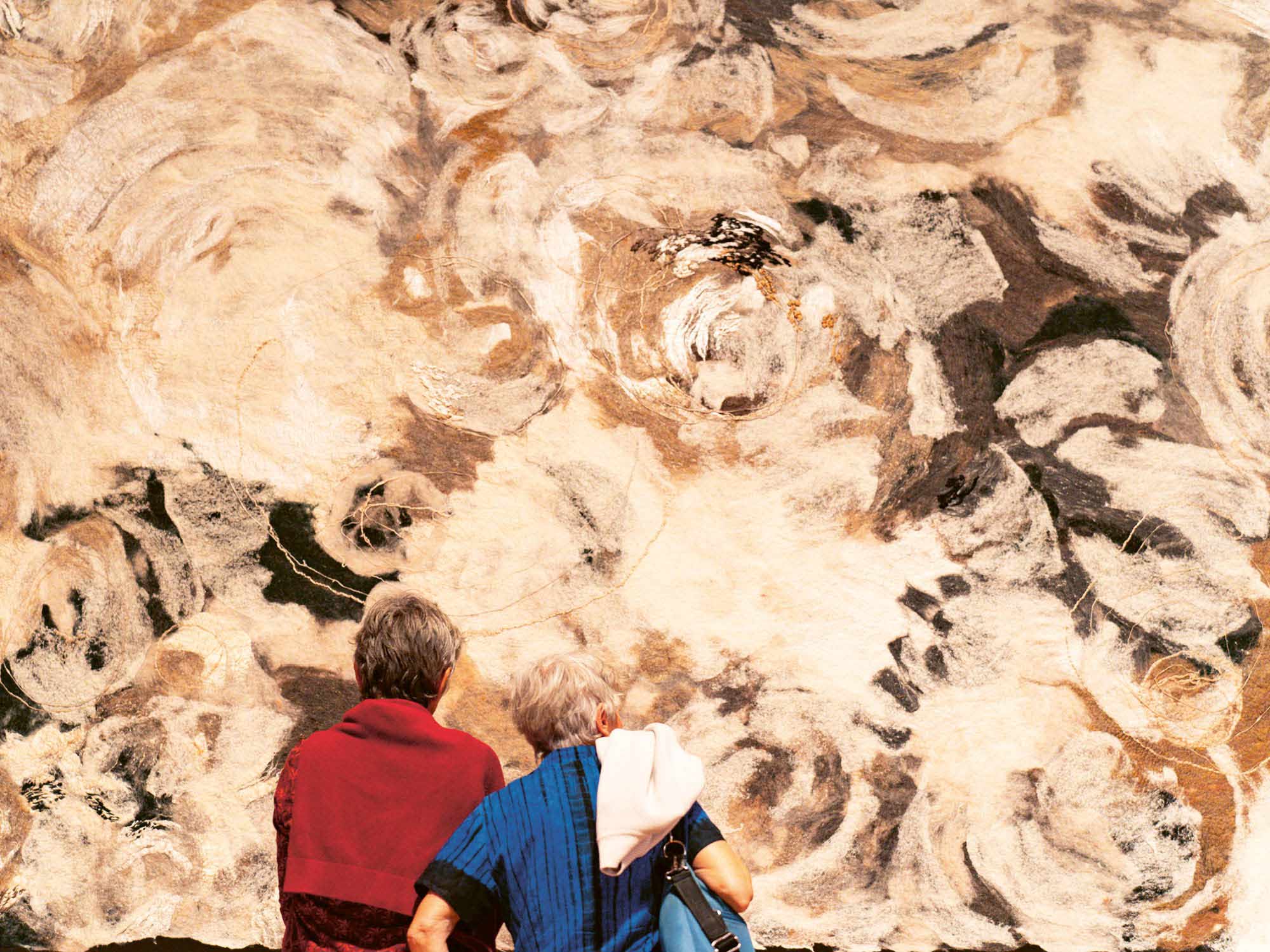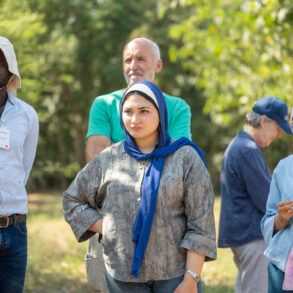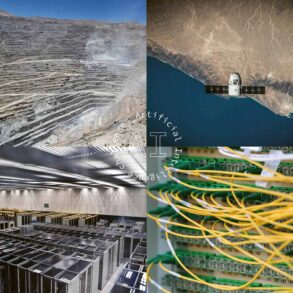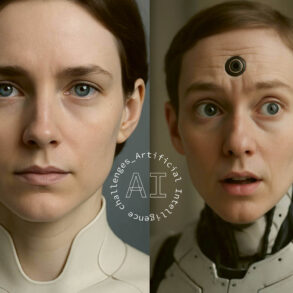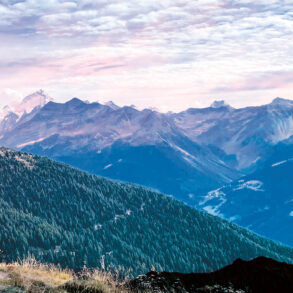At the 2023 Goetheanum World Conference, the Visual Arts Section, the Section for the Performing Arts, and the Section for the Literary Arts and Humanities offered a forum entitled “Transformation through art! What can art contribute to the current social challenges?” Each day of the forum was introduced with two presentations on topics from aesthetics, anthropology, eurythmy, architecture, painting, and social art, followed by work in small groups. At the end of June 2024, around twenty artists from the forum and the sections, from Europe and overseas, met for a colloquium that has now begun a research project.1 As an introduction to the project, here are a few thoughts on inspiration in the artistic process.
Homer begins his Odyssey with the words: “Tell me, Muse, about the man of many turns, who many ways wandered when he had sacked Troy’s holy citadel.”2 Songs are whispered to Homer through the inspiration of a muse, who helps him capture the mighty epic in speech. Here, the epic comes to him by way of a spiritual being.
In Hölderlin’s poem “As on a Holiday” [Wie wenn am Feiertage], the ‘I’ of the poem is initially able to catch the divine ray, but then his voice fails him under the divine’s shattering force: “And it is our duty, poets, to stand bare-headed under the storms of God, grasping with our own hand the Father’s beam itself . . . But alas, if from alas!” The singer’s song breaks off abruptly. He sees himself as a false priest who is cast down into darkness by the heavenly ones and “sing[s] a song of warning to those able to learn. There.”3 The will to see the world of the heavenly ones ends in an abrupt fall into the darkness of the earthly world. There, the ‘I’ finds itself confronted with itself. The former priest does not feel worthy to proclaim the message, so he can only offer a warning that approaching the heavenly realms seems presumptuous.
The aged Goethe approaches the creative sphere in a less dramatic but nevertheless deeply moving way in his “Dedication” to Faust I: “Again ye come, ye hovering Forms! I find ye, as early to my clouded sight ye shone! Shall I attempt, this once, to seize and bind ye? Still o’er my heart is that illusion thrown?” It is the dead, the kindred souls, who pass by his inner eye and rise out of the mist and fog around him, as if in a dream. He receives them, inwardly stirred. The ‘I’ feels “youthful passion shaken, from magic airs that round your march awaken.” It is the space of inspiration that opens up to the “stern heart,” which now is “tenderly unmanned,” so that it can say: “What I possess, I see far distant lying, and what I lost, grows real and undying.”4 The encounter with the dead opens the heart of the ‘I’; earthly wares move away; instead, something approaches that the ‘I’ believed already lost, but that now becomes reality.
All three types of encounters with the suprasensible, the muse, the gods, or the “hovering Forms” bring to bear another layer of reality to which the ‘I’ surrenders. In Homer’s case, the ‘I’ makes itself the organ, the mouth of this reality. In Hölderlin, the ‘I’ experiences its own limits in the encounter with the divine. In Goethe’s work, new realms of reality open up by letting go of the past. The transformation of the given occurs in and through the surrender to this other layer of reality. For the effect to arise, the artist must fulfill the prerequisite: devotion.
Today, access to the muses, the gods, or the dead is not readily at hand. In artistic creation, there’s an effort to enter into a dialog with an invisible counterpart—the artist struggles for inspiration. The world of the suprasensible and inspirational, which was still very present in Homer, Hölderlin, and Goethe, has receded into the distance and must be conquered anew by every artist. Digitalization and artificial intelligence make it more necessary than ever today to consciously turn to the sources of inspiration, thereby making it clear who is inspiring whom and whose spiritual child the artistic creations are. This question will determine the significance of art for human beings and society in the future. Do I have the ability to distinguish whether this poem is by Paul Celan or whether it was simulated by an AI and given his name?
Christiane Haid
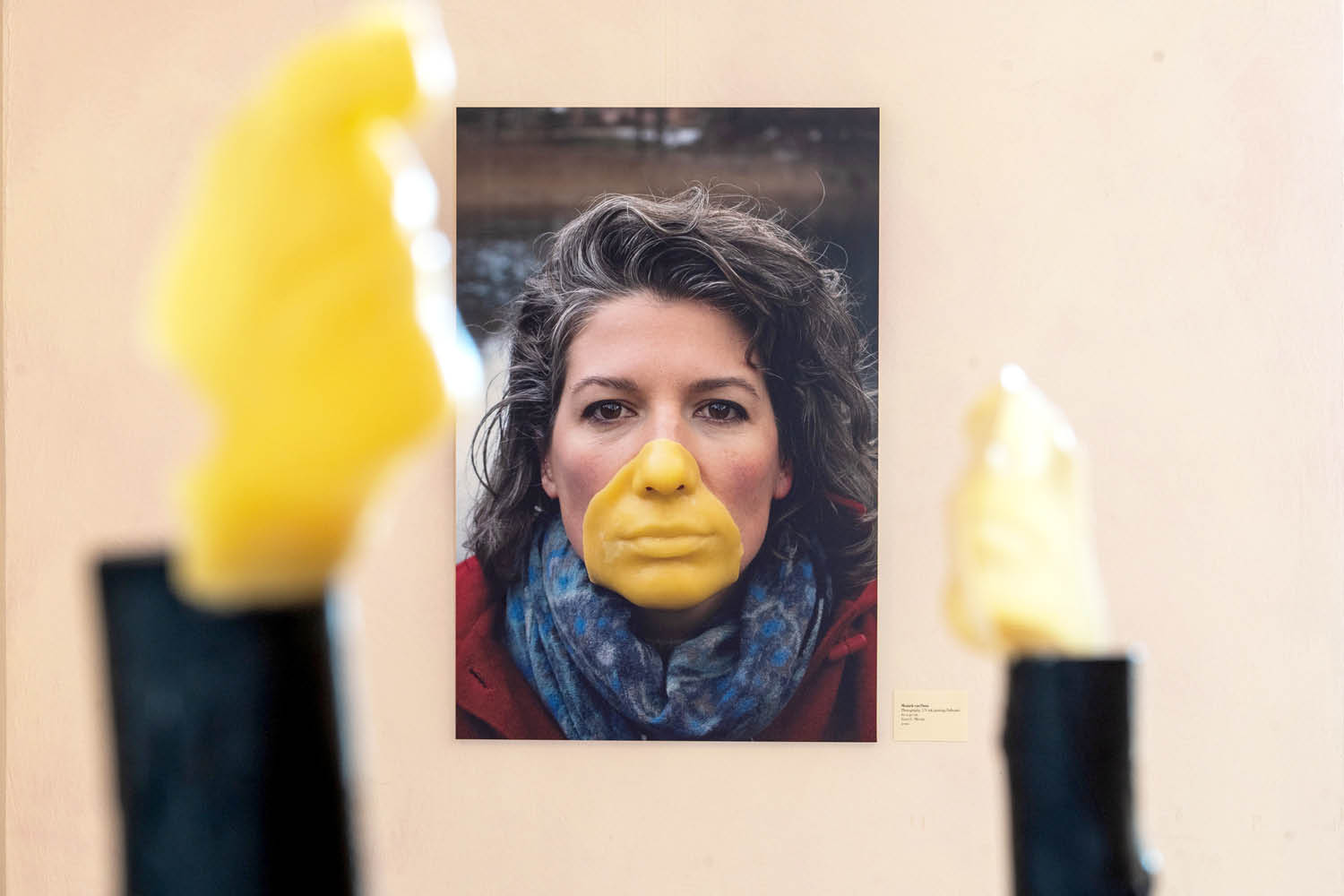
Aesthetic Experience as Transformative Force
Art, in connection with science and lifestyle, will probably have a very decisive role to play in the existential, human-made challenges of today and tomorrow. Art itself is human-made, and yet (where it deserves its name) always leads beyond itself and the individual human being. In aesthetics, all art finds its concrete connection with the search for knowledge and reflection (i.e., science) and with daily and spiritual questions of existence (i.e., lifestyle). This is because aesthetics is not merely a reflection of artistic work. Originally, and according to its definition, aesthetics is the connection between matter and spirit, between substance and form, and between the sensible and suprasensible worlds. It is the connection, interpenetration, and transformation of polarities—in humans, through humans, as humans.
An appreciation and training of aesthetic experience opens up unexpected and transformative horizons of the human being. Aesthetic experience is never one-sided; it distinguishes while, at the same time, it connects that which is different; it arises from out of that which connects without losing distinction; it is relational; it lives equally in receiving and producing; it is passive and active at the same time, like contemplation, which is effective in its ineffectiveness; it gives knowledge of a relationality that cannot be known in advance; it appears most perfect where the sensible and the spiritual really permeate each other, where perception and reflection create the unforeseeable in commensurability.
Real, unpredictable, and commensurable—like the human being himself: a creative creature that knows and produces—and eventually, produces through knowing. It is a knowing of what is known; perhaps, akin to what is human of the human being?
The “how” of creative knowing is speech; the “where” is in the heart.
Man is the knower in the same language in which God is creator. God created him in his image, he created the knower in the image of the creator — Walter Benjamin5
The language of the heart—as human experience, as human practice—is human world-receiving, human world-producing. It is humanly visible-invisible, has measure, and is aesthetic. Aesthetic experience that becomes conscious of itself is transformed into aesthetic practice. What aesthetic experience itself then experiences reaches the activity of an aesthetic practice, and reciprocally. In other words:
Knowledge in the human being is his participation in that which the beings and processes in the spiritual and physical world have to say. . . . and the human being, himself, becomes the word for the outer world he perceives — Rudolf Steiner6
Bodo von Plato
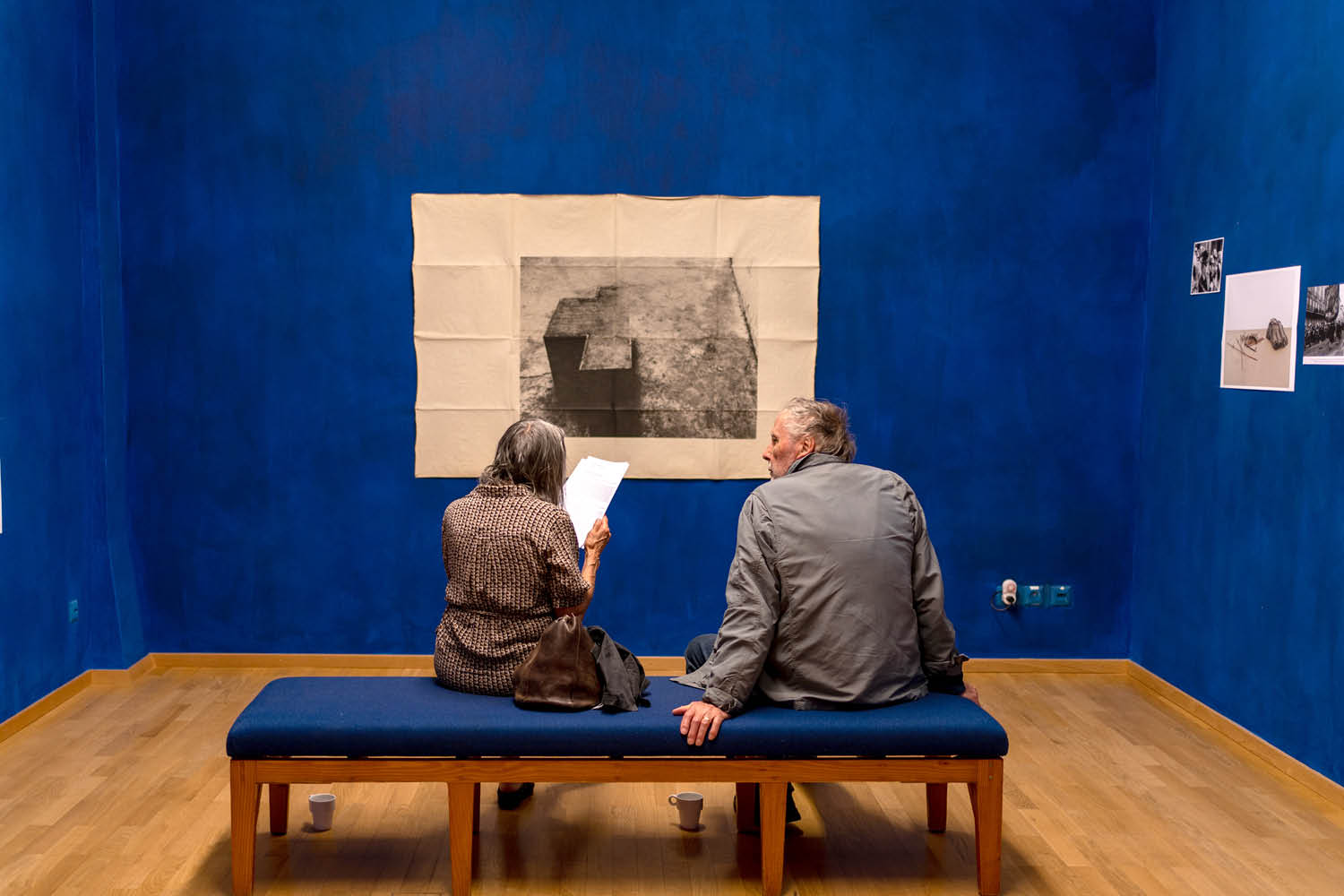
Expanding the Concept of Art
We can break down today’s challenges into three areas: problems between myself and the world around me; between myself and my fellow human beings; and, finally, with myself. This is where developing awareness, developing capacities, and developing community come to our aid—and thus, art. Since my training in Dornach, my main questions have always revolved around art and how art, or rather the artistic process, can flow into the development of community. This requires capacities that can be acquired anytime, anywhere. But, acquiring these capacities involves practice, and this is only possible through relationships, that is, in exchange with other human beings. What I can practise alone is: How can I focus my attention? Where can I reach my consciousness out to? With what do I occupy myself? If I cultivate stillness and manage myself with care, I can connect with human beings in a new and different way.
Within the artistic process, I experience self-efficacy. I take responsibility for the shaping of the artistic work. I shape the work with colors, materials, brushes, water, pencils and thereby create a composition that the viewer can “read.” This artistic process has a lot to do with the courage for not-knowing, with a zero point, and with nothingness. I have to allow myself to be vulnerable. Enduring and accepting the not-knowing is the focal point. I may have a place in the painting that I like very much, that I would like to keep. I paint around it and leave this spot alone without further changes until the moment comes when I realize how my will to hold onto something has now become a block. At some point, I realize: this part no longer fits with the whole. The whole itself has continued to develop, but this place hasn’t! I have to give it up. The other situation is when I have an area in the picture that’s a problem. I get stuck there and only work on that single area. But, this very spot ends up getting worse and worse because I no longer have the whole surroundings in view. That also becomes a block.
Both examples show that at a certain point in the process, I have to be prepared to let go. Every decision takes away opportunities, but at the same time, every decision creates new opportunities. We know this from social contexts. Letting go is also important in communities and allows the way we speak and listen to each other to create a space where something (like a painting) can emerge. That is the artistic process. In every community, this can become a process of co-creation. Silence is also very important. A painting lives mainly from enlivened in-between spaces, where there is seemingly nothing at all. That’s what makes a good painting. We can also use “tools” in communities to make this co-creativity possible in the first place. As a painter, I choose the format and materials. These are just the tools, not yet the painting. But these have to be there first. This is also the case in communities. A safe space must first be created (the format). We don’t know how exactly to do this in any given situation, but we can approach it co-creatively. This requires courage and the willingness to embrace the not-knowing.
Meret Oppenheim once asked, “Why does one make art?” and answered herself, “Because in our rationalist world, it’s the only thing that connects us to our roots . . . .”7 That’s what I would like to contribute to the future: to bring human beings into contact with themselves. That’s where we can mutually help each other as a society. That’s where co-creativity lives, where new things can emerge. That is important for the future. That is social aesthetics.
Angèle Ruchti
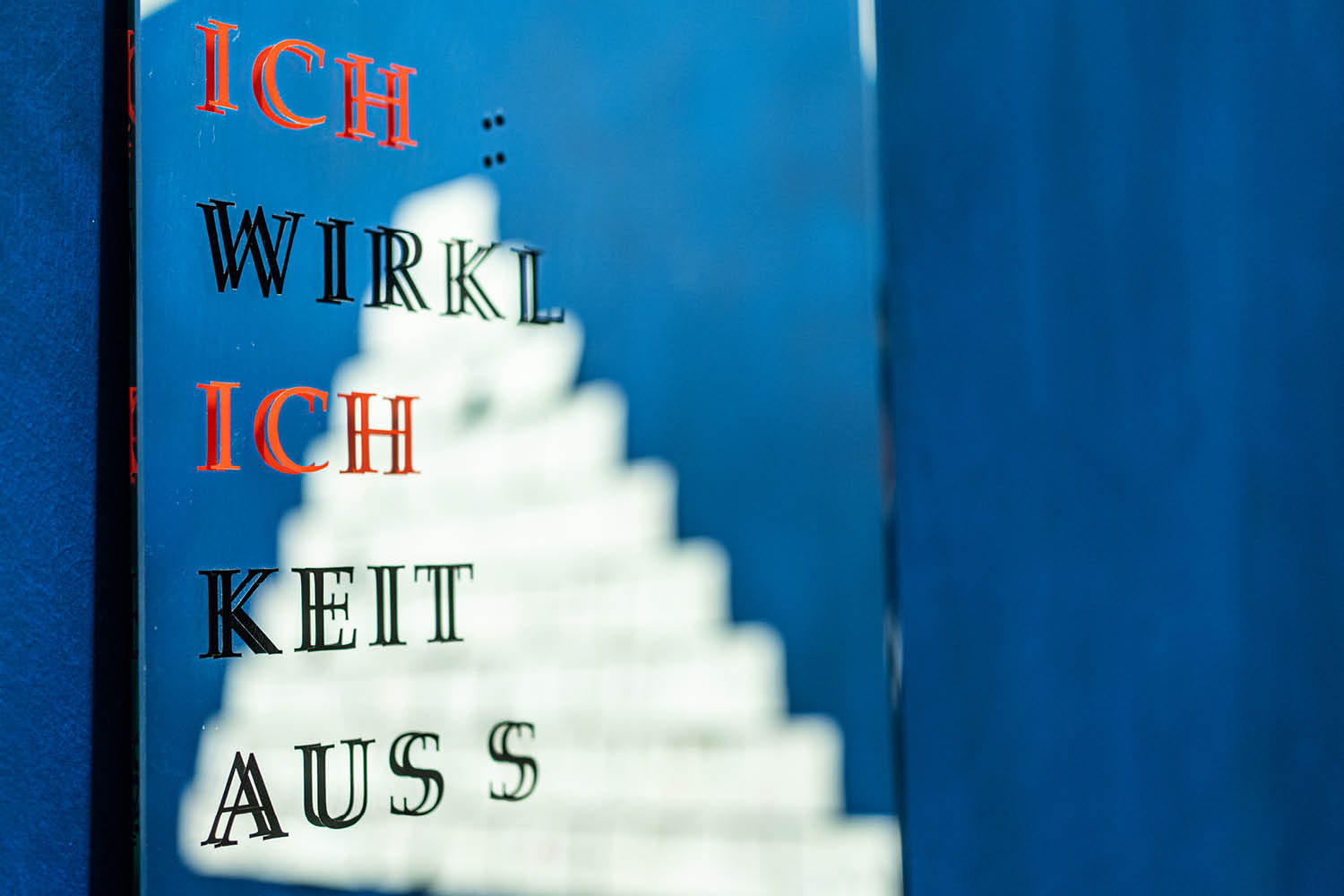
The Artistic as a Dynamic Middle
Art as an activity and experience is difficult for our thinking to grasp. Art has been present in human life since the distant past; it appeals directly to our feelings and our experiences. Art activates, stimulates, challenges, and breaks the boundaries of the familiar, and yet, at the same time, it’s a riddle for our thinking. This raises the question: What actually is art? In our present age of the consciousness soul, that which we cannot bring to consciousness, that which we cannot consciously grasp through thinking, is gradually losing its place in life and culture. A current example of this is the reduction of art classes in state education.
In many places in his work, Rudolf Steiner indicates which direction to turn to in regard to this question. His main idea is that the key to understanding the world lies in the human being. We must, therefore, form a picture of the human being through phenomenological observation, which enables us to understand our essence as a wholeness of human being and world. Where in the human being is the starting point for artistic activity and artistic experience? What constitutes the artistic element in the totality of the human being? We shift the question from the level of the product (art as a finished object) to the level of activity (the artistic as a quality, as the fundamental activity of our being).
The observation of the human being shows a fundamental polarization: On the one hand, the human being exercises a conscious thinking activity, which manifests itself in the creation of concepts. On the other hand, will activity is directed towards action. Thinking, by its very nature, corresponds with light—that is, it is a streaming activity whose fundamental gesture emanates from out of a center into a periphery. I, as an individually centered being, try to grasp the lawfulness of things (i.e., a general-universal content) through thinking. Understanding means that I, as a unique being, consciously experience the general content of a peripheral Being. The fundamental gesture of the will is the polar opposite of this. The will proceeds from out of the periphery. This is opposite to thinking’s grasping of the periphery from out of a center. The will is a strengthening and concentration through the gathering of forces, consolidation, and contraction. It exhibits a movement from the periphery to the center. The action or deed is then the specific, individualized realization of thinking’s general, universal nature.
In the middle, between thinking and willing, lives feeling. In its most elementary form, it appears as an alternating movement between sympathy, which has a warm, expanding character, and antipathy, which has a cold, contracting character. Essentially, feeling is a pulsating movement around an inner center that expresses my personal disposition towards things: pleasant or painful and so forth. But, there is also a deeper level of feeling, what we can call a transformed feeling, that points directly to reality. The artist works especially with this level of feeling. As a painter, for example, I can sense inwardly, but with certainty, that a blue spot is missing in the top left of the picture. I have no possibility of proving this through thinking, but transformed feeling, which can become a kind of organ of perception, knows it. In fact, in this respect, thinking is helpless. It can only formulate what I have perceived through that organ of experience that Steiner once called “the artistic sense.” This level of feeling can be trained and developed. The development of these capacities is one of the features that characterizes anthroposophical artistic training. Through this inner sense, we perceive compositional connections, harmony, and compatibility, that is, the “how” of the artistic act.
But, with this description, we have not yet fully exhausted our understanding of the artistic middle ground between thinking and willing. Thinking moves, like an activity of light, from the individual center to the universal periphery, whereas will moves, like a condensing and active movement from the universal to the individual center. By its very essence, the middle is the movement of turning inside-out that makes both the center into the periphery and the periphery into the center. The form of the lemniscate makes this quality of inversion visible (whereby the emphasis here is on the turning inside-out through the center). When passing through the “infinitely small” center point, the inside turns out, and the outside turns in. In our context, it is essential to note that this is precisely the point at which understanding is transformed into an impulse of will, and action, in turn, becomes a new understanding. This also means, pictorially speaking, that we ourselves must become infinitely small, thereby making it possible to traverse this turning point. The true center carries the periphery within itself and reveals itself as a transforming, pulsating movement. In the rhythmic, back-and-forth oscillation between center and periphery, the essence of harmony in the human being and in the world reveals itself. This is the core of the artistic.
The artistic element thus refers to the dynamic middle and the repeated crossing of inversion thresholds, which, therefore, also has to include the experience of rebirth through the thresholds of ignorance and powerlessness. From here, we can also understand why the middle is so difficult for our thinking to grasp. The poles are clearer and more easy to comprehend. The role of thinking and the criteria of its action are the subject of the scientific method. The will fulfilled in the deed is put to the test in practical life: It either works or it doesn’t. But, in order to comprehend the middle as a pulsating movement, we need to develop a new way of thinking that is itself based on movement and transformation.
In its special quality as the middle, the artistic contains both the specific and the general. It appears as specific, but it’s not fully realized in its appearance, that is, it has no direct influence on external reality and as such carries the general within itself, though without becoming a concept. For example, the apples painted by Cézanne cannot be eaten, but at the same time, they are not merely a demonstration of the concept of “apple.”
Thus far, I have tried, above all, to grasp where the artistic process is located within the human being, but I have not yet referred to the creative activity of the artistic process itself, that is, to the encounter with the material and the shaping and processes of manifestation associated with the respective medium. This creative movement can also be described as a conversation that arises between the creator and the created, as well as between the created and that which wishes to be revealed. The appearance of the Other in a poem, painting, or other artistic work requires me, as the creator, to step back and make space for what appears. Clearing this space makes it possible to visualize the Other in the work. This process requires a high degree of attention and can lead to a painful inner silence. It is a movement towards the unknown that speaks from the future, the future, which itself carries the mystery of “dying and becoming.” I must be prepared to give up everything I have brought with me and surrender to what appears in such a way that it is able to receive the conditions for its manifestation. This is where the artistic element arises in the encounter with the material, with the medium through which it can work in the world as a picture, as sound, and as word. It is the in-between-space of the “sensible/suprasensible,” in which the material itself rises to the spiritual without losing its sensible essence.
Lastly, the question arises: what place does the artistic element have in human life? From what has been said thus far, it is clear that it’s not necessarily limited to the realm of art in the narrower sense of the word. We have the possibility of transferring this transformative sphere of the middle to all areas of human life and activity. For example, education, medicine, or any other area of life can itself become an art when attention is focused on the middle sphere and this sphere’s conditions for life. In this way, the social sphere can take up the artistic element and eventually become “social art” through profound transformation processes in the sphere of destiny, where lies the unredeemed past of the will. What, then, is the place of the individual artistic work, the painting, the sculpture, the symphony, the play, or the eurythmy performance in the totality of life? It’s a place where the artistic element can be experienced as a totality in a concentrated, clear way and, as such, can indicate and prepare for a possible future. Art thus becomes the guiding principle of the “social art” that aims for harmonization of the sphere of karma.
Iftach Ben Aharon
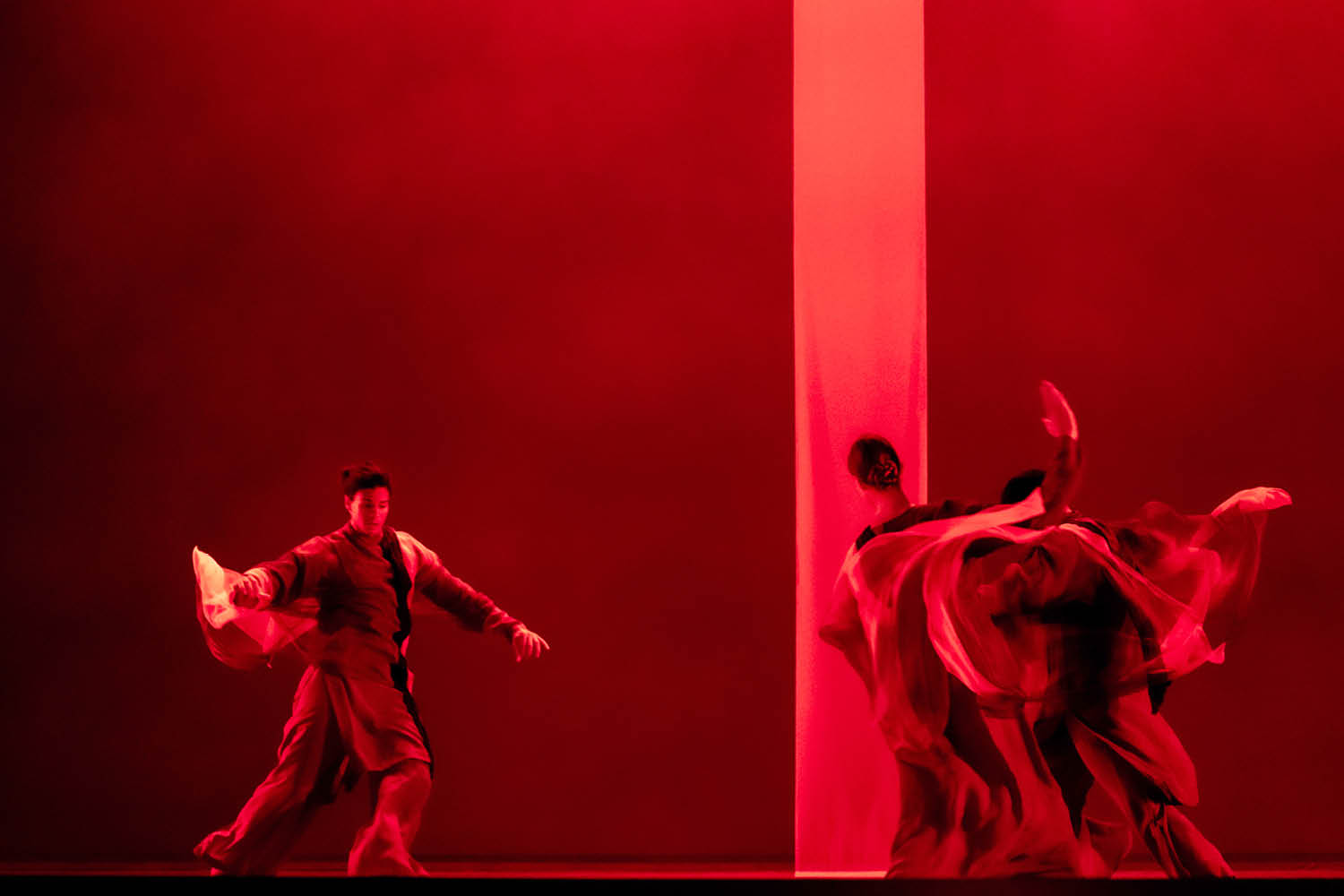
We Shape the Sacred Temple of Our Body
There is but one Temple in the World; and that is the Body of Man. Nothing is holier than this high form. — Novalis8
Novalis echoes something Rudolf Steiner described as the transformation of the body by the spirit dwelling within it: “What has happened to [the body] can only happen through the fact that this body is permeated by the spiritual-soul forces of the human being.” He speaks of the human body after death as yeast for the Earth, which is what actually makes the Earth’s further development possible in the first place.9
Boundary, threshold experiences, and deep transformations are possible in all the arts. When we speak of transformation through art, our own transformation and reshaping is a reasonable question. In that, we live in our bodies, we transform them, and we are all artists in the sense of Joseph Beuys. We, ourselves, shape the sacred temple!
As a eurythmy teacher, I immediately think of the questions and motives of the students who are now just beginning to study eurythmy. Most of them are in their early twenties. Despite all the individual differences in their personal questions and objectives, one motive for this course of study is especially common: the deep longing to become human: I’m not a finished human being; I’m one who is becoming, and I believe that the artistic path in particular has the potential to enable me to develop fully as a human being. There is a great longing and a great trust that the art of eurythmy, where one reshapes oneself into an instrument, can offer this possibility in an especially unique way. The young eurythmy students want to be perceived as spiritual beings upon this path of artistic training, to be addressed and encouraged in their thinking, feeling, and will. There’s a need to be challenged physically, soulfully, and spiritually, to give names to sensations, to recognize thresholds in full wakefulness, and to learn how to deal with them. One gets the impression: This is serious! It’s now even more important to be well-prepared! I’m preparing myself, and I’m doing so on the path of artistic training. Upon the training path of eurythmy, the transformation of the body is also an important theme. And what happens when we do eurythmy collaboratively in a choir? What kind of quality is there when this transformed body is not only permeable to its own creative individuality but also makes it possible to experience the spiritual-soul presence of another human being (a poet or composer) through eurythmy in poetry and music? Transformation through art. Becoming human through art.
Tania Mierau
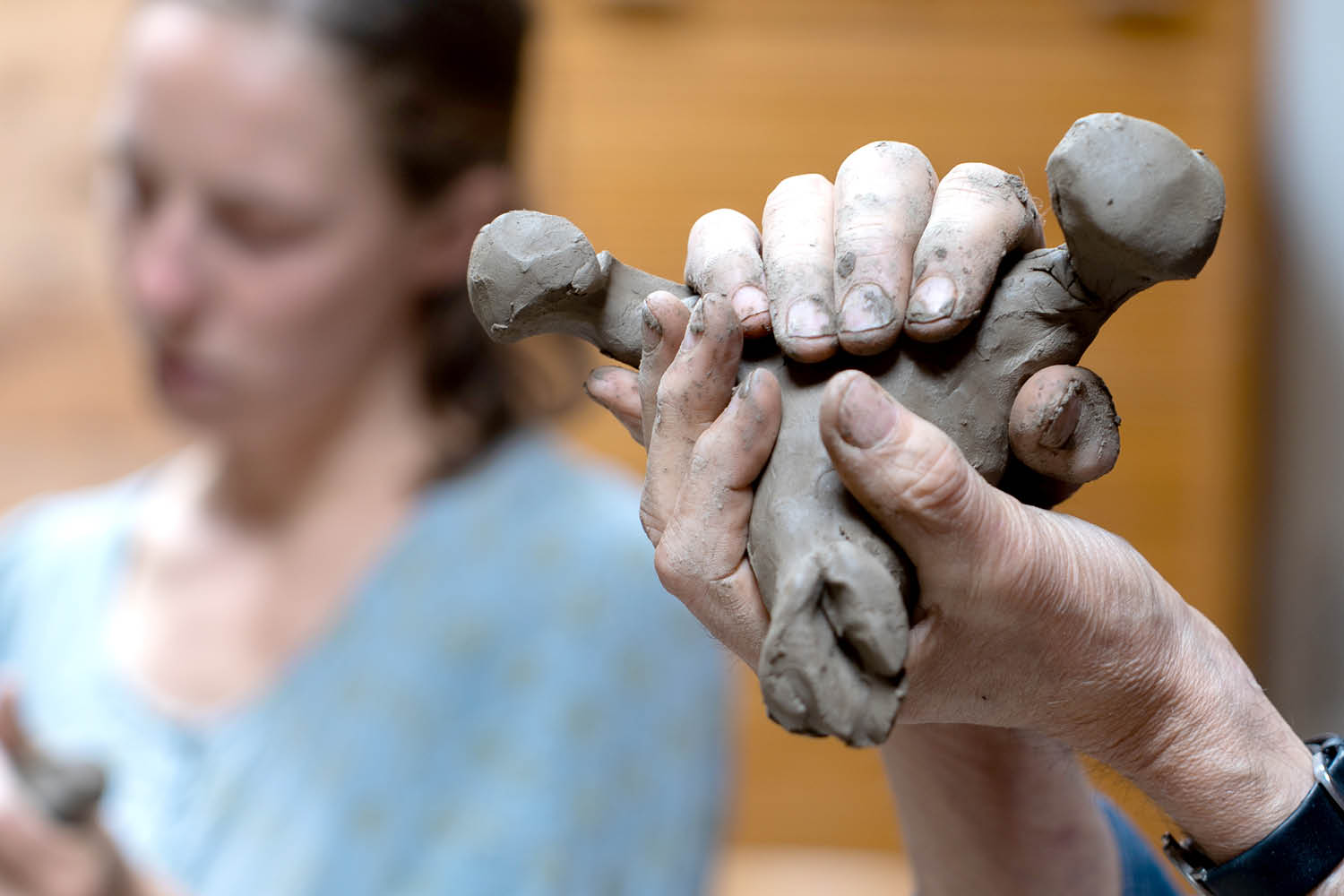
The Role of Anthroposophical Arts in the World
Our world finds itself in a crisis. All around us, the natural world is melting away or burning up. Meanwhile, AI technology and transhumanism are advancing at an alarming rate, destabilizing our basic ideas of what it means to be human. Both the outer and inner crises are the result of a way of thinking that dominates our Western worldview. On one side, human beings feel separated from the spirit within nature; on the other side, we feel separated from the spirit within human beings. In contrast to the so-called objectivity of the modern scientific view, concerned with the “corpses” of the living world, the arts warm and enliven us through the experience of “crawling into the thing.”10 By cultivating artistic feeling, “artists give the world . . . manifestations of the spiritual world.”11
Through the arts, each and every one of us gains gifts of insight and forces for life. These experiences of knowledge and these forces have a purpose beyond our own development and the role they play within the Anthroposophical Society. By strengthening ourselves, we thereby enable ourselves to engage with the world. As anthroposophists, we don’t have the possibility to withdraw into our own activities and institutions like hermits. In the lecture “Technology and Art,” referring specifically to the technology of modern times, Rudolf Steiner said: “Everything that has the character of withdrawing from the influences we must necessarily encounter springs from weakness.”12 In a lecture on February 6, 1921, he spoke even more directly: “Humanity must become conscious of the fact that one must not somehow accuse or extinguish that which modern cognition has brought about; humanity must become conscious of the fact that one must not reject for the sake of comfort that which the modern view of nature provides; but rather that one must carry into this modern view of nature a completely new spiritual knowledge . . . . They must carry spiritual life into this civilization.”13
As artists working from out of spiritual science, we hold keys in our hands that can open doors to soul-strengthening experiences and an enlivened relationship to the world and to ourselves. We work with things like process and the in-between and understand that “all philosophy . . . proceeds from . . . wonder.”14 “For art will orient and is oriented towards the living.”15 As artists and art lovers, we actively engage with this valuable way of knowing.
Crises can inspire creative solutions that nobody has taken seriously before. For example, there is a video on YouTube in which the Chinese tech entrepreneur and millionaire Jack Ma is asked at the World Economic Forum about teamwork and education. He says that, for the last two hundred years, education has been based upon knowledge. “But, we cannot teach our kids to compete with machines, who is (sic) smarter; we have to teach something unique. . . . [V]alue, believing (sic), independent thinking, teamwork, care for others; these are the soft part; the knowledge (sic) may not teach you that. That’s why we should teach our kids on (sic) sports, music, painting—art!”16
This is a decisive moment for each and every one of us in our own individual context and field of activity. Do we have the force to stand up as anthroposophical practitioners of art, to find our voice, and to speak up for art and what it can contribute to nourish and enliven the human soul? Can we become advocates for art and artistic intelligence? Can we imagine developing resource centers that offer artistic possibilities for every human being currently awakening to the need to explore what is truly human? Have we begun to question our language and attitudes in order to provide a welcome space for those coming? Can we muster the courage to offer the nurturing, humanizing forces of art?
Coralee Frederickson
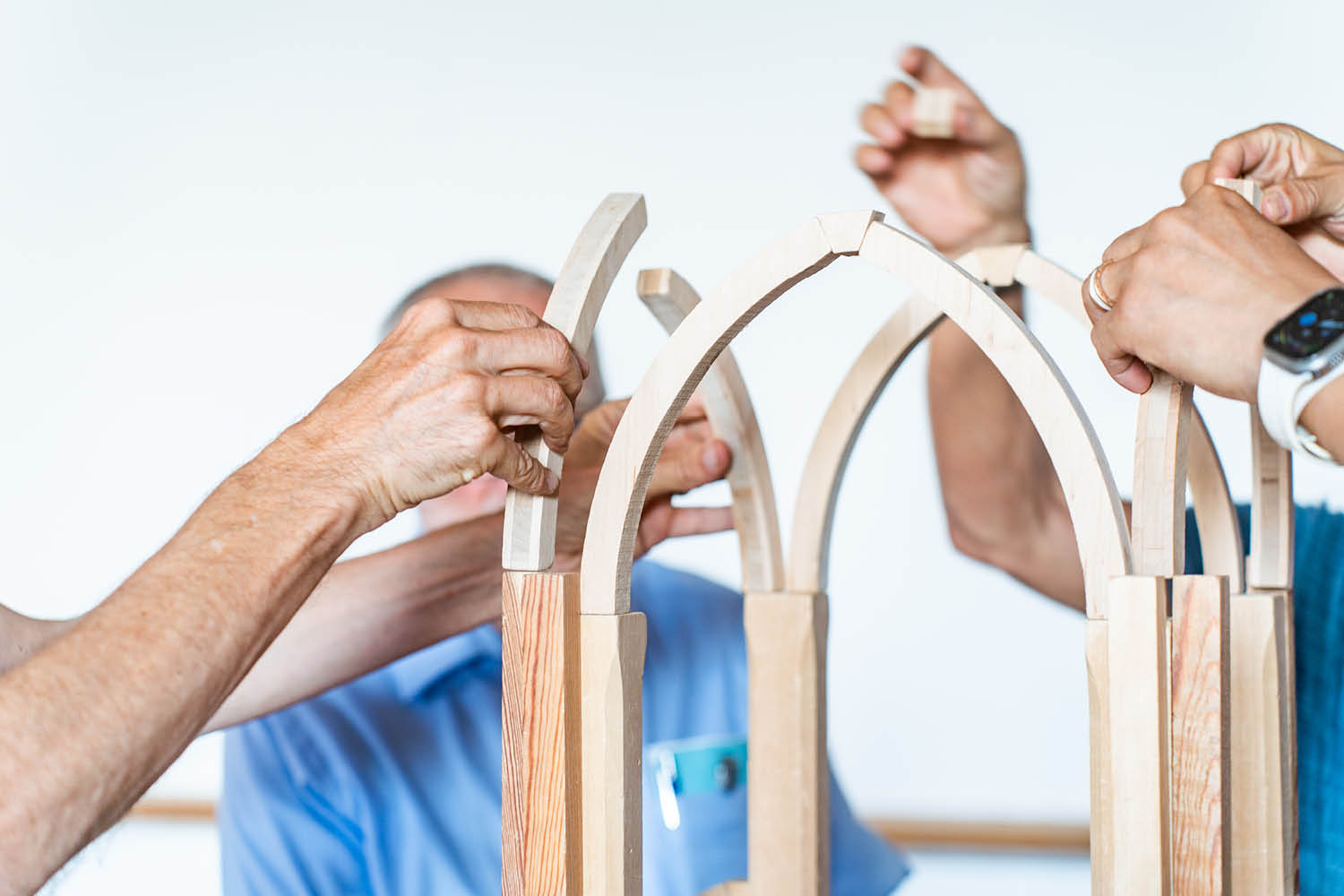
Architecture in a Field of Tension
Today, architecture lives in a challenging field of tension: on one side, we have the climate crisis and, on the other, the new possibilities of artificial intelligence. The awareness of the climate crisis is transforming architecture. Buildings are now able to be disassembled and have become recyclable, made suitable for new buildings. The result of these new approaches is that architecture is becoming more and more temporary. It seems to me that there is a danger of one-sidedness here because if the building is reduced solely to its material resources, it becomes a technocratic plaything without forming memories or even making history. For, remembering a building, the way it’s built, what it says to me, what it means to me, personally, is a fundamental human experience that’s part of our lives and forms our sense of identity on the Earth. We build in order to remember, to orient ourselves, to get to know ourselves. Indeed, we build in order to find our way. But, in a one-sided effort to achieve sustainability, we’re in the process of seemingly erasing this central meaning and role that architecture used to have. Memory forges a connection, and isn’t connection a central, immaterial aspect of sustainability? With composite and circular building, we focus strongly on the fact that the building components themselves, the products, and the materials we use still have an economic value at the end of the architectural life cycle. Suddenly, the material, which was otherwise a means to an end, has become the main purpose. Architecture, which we’re “still” dealing with, seems to have become nearly “disposable.” It no longer has any meaning in itself; it’s merely something temporary.
On the other side, artificial intelligence can now conjure up fantastic forms for us: sculptured, seeming strangely alive, even organic, and very seductive! A world of forms not yet imaginable or conceived has now become possible. But here, too, the question arises as to whether the essential basic experiences of architecture can still be experienced in these so lavishly formed shapes? Or asked the other way around: Don’t we have the task of developing a consciousness for what is really alive, for what is really organic, for original thoughts, for what is individually artistic?
There seems to me to be a kind of hypnotic effect in both directions of these extremes. But simply being mesmerized is not what the beautiful is about. This kind of fascination has the potential to become one-sided, which is precisely why it’s so fascinating. In both extremes, there seems to me to be a tendency to extinguish the human element. Our individual and creative humanness is in danger of being lost due to this ever-increasing one-sidedness. In both extremes, technology is taking over the creative process and deeply interfering with our truly human experiences of architecture. However, I do see our task today as working in and with both approaches. But this also means defining what is truly human and artistic. A huge task in terms of content.
How do we save the humanity in our architectural surroundings and art? That which is truly creative within human beings is always addressed through a love of the spirit, a love with which human beings can develop true love for the Earth. With the consciousness that we are still at the very beginning of this path, it seems to me that it is our task to dedicate ourselves to the spiritual with love in every artistic process. We, ourselves, can engage with this practice, allowing the motifs to come alive in and through us. We concentrate on the spiritual; we work our way into this world. And then (sometimes) we notice that something flows towards us from out of this world, something “new” that’s transformed through our hands and takes shape upon our Earth. What was in the inner space of the spirit is transformed, through our creative work, into the outer space of the world. Our hands connect us with the spiritual. Our hands thereby connect the cosmos and the Earth. It is an essential phenomenon: I connect myself content-wise with the motif as an ideal; the material artistically transforms in this process, develops through what flows through my hands, and thereby rises into the sphere of the ideal, into beauty. This can only be done by a human being!
Yaike Dunselman
Translation Joshua Kelberman
Title image Claudy Jongstra, “Guernica de la Ecología” (2021) at the Goetheanum World Conference 2023, Photo: Xue Li
Footnotes
- If you are interested in collaborating, please contact the Section for the Literary Arts and Humanities or the Section for the Performing Arts.
- Homer, The Odyssey: A New Verse Translation, translated by Albert Cook (New York: Norton, 1967).
- Friedrich Hölderlin, Poems of Friedrich Hölderlin: The Fire of the Gods Drives Us to Set Forth by Day and by Night, translated by James Mitchell (San Francisco: Ithuriel’s Spear, 2007), 26–31.
- Johann Wolfgang Goethe, Faust: A Tragedy, vol. 1, translated by Bayard Taylor (New York: Houghton Mifflin Co., 1870), 1–2.
- Walter Benjamin, “On Language as Such and on the Language of Man,” Reflections: Essays, Aphorisms, Autobiographical Writings, translated by Edmund Jephcott (New York: Mariner Books, 2019).
- Rudolf Steiner, Autobiography: Chapters in the Course of My Life, 1861–1907, CW 28 (Great Barrington, MA: SteinerBooks, 2006), 164–65, 172.
- Meret Oppenheim, “Frühstück in Pelz: Die Welt der Meret Oppenheim” [Breakfast in fur: the world of Meret Oppenheim], January 8, 2016 in Deutschlandfunk: Feature, produced by Daniela Schmidt-Langels and Otto Langels
- Translation quoted from Thomas Carlyle, “Novalis,” Carlyle’s Miscellaneous Writings. The Modern British Essayist, vol. 5: Thomas Carlyle (Philadelphia: A. Hart, 1852), 181.
- Rudolf Steiner, The Foundations of Human Experience, CW 293 (Hudson, NY: Anthroposophic Press, 1996), lecture in Stuttgart on Aug. 23, 1919, p. 71.
- Rudolf Steiner, Art as Seen in the Light of Mystery Wisdom, CW 275 (Forest Row, East Sussex: Rudolf Steiner Press, repr. 2010), lecture in Dornach on January 2, 1915.
- Rudolf Steiner, Transforming the Soul, vol. 2 (Forest Row, East Sussex: Rudolf Steiner Press, 2006), lecture in Berlin on May 12, 1910, “The Mission of Art.”
- See footnote 10, lecture in Dornach on December 28, 1914, “Technology and Art.”
- Rudolf Steiner, Die Verantwortung des Menschen für die Weltentwicklung [Human beings’ responsibility for world development], GA 203 (Dornach: Rudolf Steiner Verlag, 1989), lecture in Dornach on February 6, 1921. English translation by Dorit Winter is forthcoming from SteinerBooks.
- “[A]ll philosophy, all deeper reflection on the mysteries of existence proceeds from what one may call wonder or astonishment.” Rudolf Steiner, Earthly and Cosmic Man, CW 133 (Blauvelt, NY: Garber Communications, 1986), lecture in Berlin on May 14, 1914.
- Rudolf Steiner, The Arts and Their Mission, CW 276 (Hudson, NY: SteinerBooks, 2023), lecture in Oslo on May 18, 1923.
- Jack Ma on the future of education, Jan. 26, 2018, by TEAM MUSIC, Youtube, 1:59 mins.

